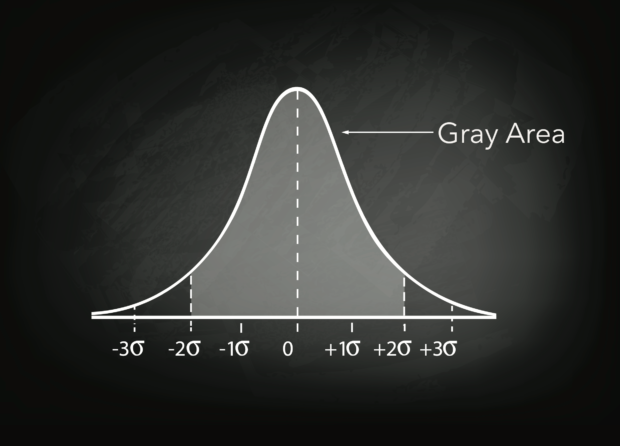Let’s start with the normal distribution curve.
Have I lost you already?
Most of us know the normal distribution curve, also known as a bell curve. It sits on an x/y axis. It starts low, gradually rising up, hits an apex and then descends back down to the same low level where it began. The left-side tail and right-side tail are mirror images of each other. It looks like a lovely, single rolling hill. The normal distribution curve has three sections: the left tail, the fat middle and the right tail. The area under the normal distribution curve represents probability, and the total area under the curve sums to 1.
Executive Summary
Don’t be stuck in a binary belief system of always or never. Such extremism divides us as people, teams and organizations, writes CM Guest Editor Don Bailey. Instead, we need to find the gray area by embracing intellectual humility, seeking different perspectives and finding common ground.Over the years, I have come to learn quite a bit about myself and the functions of teams and organizations based upon this curious curve. Cognitively, I spent way too much of my time in the tails and not nearly enough in the middle. My beliefs about people and the world persisted in the extremes. I was “for” something or “against” something.
- He was either a great leader or a terrible leader.
- The sales plan could only be terrific or horrible.
- The investment proposal was perfect or a nightmare.
- The budget is completely rational or utterly ridiculous.
I was seemingly unable to hold two truths simultaneously. Please linger on that prior sentence for a minute. Be careful of single-story narratives. When someone tells you (or you tell yourself) a story that is devoid of nuance, elegance and gray, be careful. Things are rarely always “this” or never “that.” Always and never are dangerous and generally don’t exist. This world contains a scarcity of absolute truths. Resist giving life to always and never.
Unfortunately, our world has become increasingly about the tails—about desperately clinging to a single truth, to outliers. People’s belief systems have become binary. Decisions are now only a choice between two opposing options. This practice of extremism is neither helpful, nor practical. It divides us as people, teams and organizations. I am constantly being forced into being for something or completely against it. Why do I have to be with one team or the other? Isn’t there a third team?
Yes, there’s the gray team! The world is gray. It’s nuanced. Elegance persists in all things. Extremism accounts for as much as 30 percent of the world. Are we better served by believing that 30 percent equals 100 percent, or is the 70 percent (or more) that we are ignoring what really matters? Reality exists in the 70 percent. Truth exists in the 70 percent. In the 70 percent, we are required to hold two truths.
Let’s bring this to life. What are a few of the most polarizing “always/never” topics today?
- Climate change
- Race
- Guns
- Politics
- Millennials
Depending on where you live—literally and metaphorically—you will tend to have a distinct opinion on these topics. You hold a single truth on each of these topics (e.g., guns are bad). You have a single narrative that you cling to on each subject (e.g., climate change is not real).
With each of these topics, we can apply the normal distribution curve. The one-truth extremes are easy to outline. A one-truth mindset equates to intellectual laziness. The harder effort is in the middle. The middle requires us to hold two truths—to see and embrace the gray. It demands three things:
Intellectual humility. Can you embrace the fact that you don’t know everything? Intellectually humble people realize there is always more to the story, and they revel in learning more and getting better (the growth mindset). They seek out the gray.
Perspective taking. Do you appreciate that true wisdom comes from deep knowledge of a topic or concept? Your perspective alone is a limiting factor. Perspective takers are committed to escaping the echo chamber we naturally build for ourselves by seeking and learning from other points of view. Perspective takers know that more perspectives create better solutions.
Common ground. Can you appreciate that you may actually agree with the other side on certain aspects of the topic? The science of debate dictates that you find common ground with your counterparty in order to create credibility for your position. Common ground is a precedent to change.
The world is competing for our attention. One of the effective tools of extremism is the short form: Twitter, LinkedIn posts, etc. These pithy and emotional proclamations seize our attention and color our perceptions. They demand a distinct black or white position. There’s no time for nuance and elegance in short form.The middle takes more time, requires more work and much more of an intellectual exercise. Today, we have made ourselves so busy we are unable to find the elegance in things. Our busyness blocks complexity—we simply don’t have time for anything complex, so we avoid it. I have come to appreciate things and people that are not simple. They take more time to know and understand. Complex things are often never mastered, but that journey of mastery is a precious and joyful one. Truth, reality and wisdom are embedded in complexity. Wisdom is not about knowing many things; it’s about knowing one thing deeply.
We must be purposeful stewards of our attention.
We must resist the natural temptation to accept simple explanations for complex things.
We must not allow extremism to paint a picture of the landscape and chart our course for the future.






















 New York Times Sues Perplexity AI for ‘Illegal’ Copying of Content
New York Times Sues Perplexity AI for ‘Illegal’ Copying of Content  Executive Utterances: On Presenting
Executive Utterances: On Presenting  Why Insurance Telematics Integrations Fail
Why Insurance Telematics Integrations Fail  How One MGU Grew Fivefold When Capacity Fled Cat-Prone Property Markets
How One MGU Grew Fivefold When Capacity Fled Cat-Prone Property Markets 








